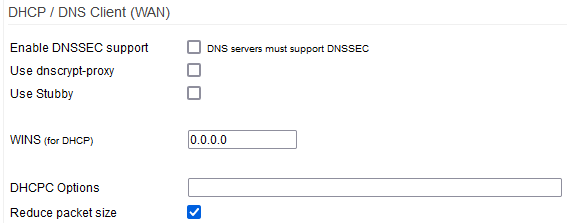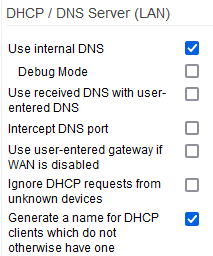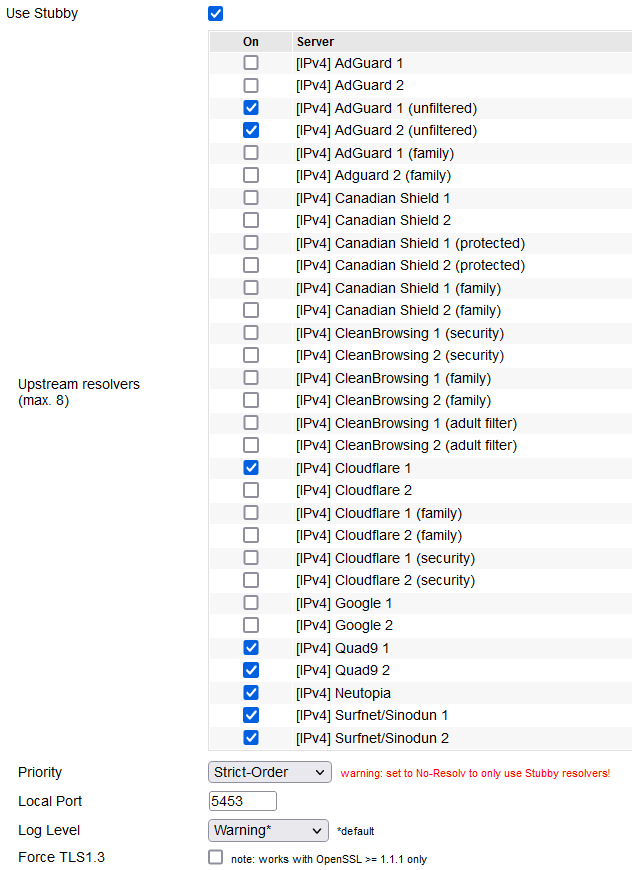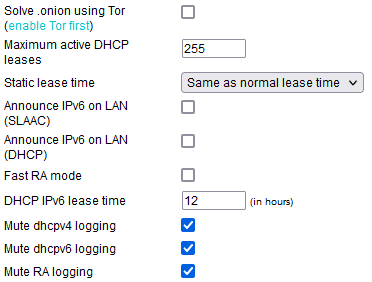Advanced-dhcpdns
DHCP/DNS/TFTP
The DHCP/DNS/TFTP menu allows you to configure advanced settings for the DHCP, DNS and TFTP services for both the LAN and WAN. Most of this functionality is provided by dnsmasq.
DHCP Client (WAN)
The DHCP Client (WAN) section includes a dhcpc (dhcp client) options field. Here you can set parameters for your router's DHCP client.

Enable DNSSEC support: DNSSEC is a way to secure DNS by introducing authentication for DNS servers. This prevents DNS hacking and poisoning. If the authoritative DNS server has DNSSEC, enabling DNSSEC ensures your DNS queries are answered by that DNS server, and not an imposter.
DNSSEC is not encrypted, to keep it backward-compatible with traditional DNS. Enable this if your chosen DNS server supports it for enhanced security.
Use dnscrypt-proxy: DNSCrypt encrypts DNS resolution. When a DNSCrypt-enabled server is chosen, a unique key pair is generated and regenerated every hour. Queries are then encrypted using the generated key pair before being sent to the server, usually on TCP port 443. The reply is similarly encrypted. Checking Use dnscrypt-proxy enables the built-in dnscrypt proxy client. The dnscrypt module and Stubby cannot be used at the same time.
When dnscrypt-proxy is checked, the following options/fields are revealed:
- Ephemeral Keys - If checked, a new key pair is generated for each DNS query. Use this with care. It is very cpu-intensive, so it may slow DNS resolution.
- Manual Entry - If enabled, 3 more fields are displayed:
- Resolver Address - This is The IP address of the dnscrypt-enabled DNS server.
- Provider Name - This is the name of the DNS provider, for instance Tomato64.
- Provider Public Key - The public key provided by the DNSCRYPT-enabled DNS provider (to generate a key pair)
- Resolver - This dropdown list currently contains about 200 DNS servers.
- Some support DNSSEC.
- Some don't log queries.
- Some are filtered.
- Priority - This should be left at no-resolv to prevent DNS leaks. This should never be a choice when using DNSCRYPT. Also, to prevent leaks, enable Intercept DNS port.
- Local Port - Specifies the port on which dnscrypt-proxy communicates with Tomato64 DNS. Leave this at 40 unless you're a highly advanced user. Do NOT set it to 53, as doing so may create a loop.
To help you choose a DNSCrypt DNS provider, import the file /etc/dnscrypt-resolvers.csv in a spreadsheet. Once chosen,
the server's IP address, provider name, and public key can be taken from that file.
Use Stubby (DNS-over-TLS): This enhances DNS privacy. Checking this enables Stubby, a DNS Stub resolver.
DNS over TLS (or "DoT") sends DNS queries over a secure connection, encrypted with TLS. TLS is the same technology
that encrypts secure Web traffic. This prevents third parties from seeing your DNS queries.
When Stubby is enabled, some further options appear:
Upstream resolvers: Here, specify the upstream servers responsible for performing the actual name resolution.
Priority:
- Strict-Order - Stubby is tried first, but if issues aries, fallback will occur to other name resolution methods, like standard DNS.
- No-Resolv - If Stubby fails or has issues, there will be no fallback to other DNS resolution methods.
- None - This adds Stubby as a resolution method for dnsmasq. This alone does not guarantee.
Local Port: This is the port number on which Stubby serves clients. Dnsmasq will be the only client for Stubby,
but it is dnsmasq that serves clients.
Log Level: Here, you can choose what level of details is written in log entries.
Force TLS1.3: Enforces usage of the latest TLS version for encryption. This must be supported upstream.
WINS (for DHCP): Here, specify the IP address of a WINS Server to be be given to DHCP clients. This doesn't actually enable WINS. Tomato64's WINS Server function is enabled on the File Sharing menu.
Windows Internet Name Service (WINS) is a legacy name resolution service that maps NetBIOS names to IP addresses. Officially, it's outdated and largely obsolete. DNS was supposed to replace WINS functionality. However, Microsoft has not officially deprecated WINS. WINS may still be necessary for some Windows LAN browsing functions on old Windows versions.
DHCPC Options: In this field you can enter custom configuration settings for the dhcp client.
Reduce Packet Size: udhcpc (the DHCP client Tomato64 uses to obtain a WAN IP address) has a problem. It has a DHCP discovery packet size 590 bytes long. However, DHCP relay servers can only handle DHCP discovery packets up to 576 bytes. If there are DHCP relay servers between your Tomato64 router and your Internet provider's DHCP server, Tomato64 might fail to acquire a DHCP lease on the WAN interface.
The extra bytes were entirely padding, and therefore, unnecessary. Tomato64 developers eliminated the padding, reducing udhcpc's DHCP discovery packet size to 331 bytes. This 331 byte size eventually became the default setting. As a result, udhcpc can successfully obtain a DHCP lease from an ISP with DHCP relays. However, some users may not be able to obtain a WAN IP address unless they disable this feature. (Default: Enabled).
DHCP / DNS Server (LAN)

Use internal DNS: Uses dnsmasq as the DNS server on your LAN. DHCP clients will receive your router's local IP address as the DNS server. (Default: Enabled).
Debug mode: Checking this makes Tomato64 write detailed information to the log file.
Use received DNS with user-entered DNS: Add DNS servers received from DHCP on your WAN connection to the manual DNS server list. Please See the Network menu for more information. (Default: Disabled).
Intercept DNS port: Configures any DNS requests/packets sent on UDP/TCP port 53 to be redirected to the internal DNS server. Only IPv4 DNS requests are intercepted. (Default: Disabled).
Use user-entered gateway if WAN is disabled: Enabling this will makes DHCP assign the router's IP address as the default gateway on the LAN. (Default:Disabled)
Ignore DHCP requests from unknown devices: Enabling this makes dnsmasq ignore DHCP requests from MAC addresses not listed in DHCP Reservation. These clients will not obtain an IP address via DHCP. This setting is also available in the DHCP Reservation menu. (Default: Disabled).
Generate a name for DHCP clients which do not otherwise have one: If a hostname in the device list is not reported, this will automatically generate a name for it, based on the device's MAC address.
Solve .onion using Tor: If Tor is enabled, this option causes it to resolve ".onion" domains. This allows proper DNS resolution on the Tor network.
Tomato64 has a built-in Tor client. For more information about this, see the TOR page.
Maximum active DHCP leases: Sets the maximum allowed active DHCP leases at one time. (Default: 255).
Static lease time: Sets the absolute maximum valid time for any DHCP lease.
- Same as Normal Lease Time
- Static lease time is the same as normal (1440 minute) lease time. (Default.)
- Infinite
- Static lease time is infinity
- Custom
- This setting allows you to enter a custom Static DHCP lease time.
To retain leases after rebooting the router, please see this HOWTO for additional information on non-volatile DHCP leases.
Announce IPv6 on LAN (SLAAC): Enabling this turns on router advertisements for IPv6 (SLAAC) protocol. This protocol allows hosts to self-configure an IPv6 address with minimal contact with a server.
- The client sends out an RS (router solicitation) ICMP packet.
- The nearest router responds with an RA (router advertisement) packet.
- The client uses the IPv6 prefix from the RA packet as the first 64 bits of its address. It then derives the last 64 bits
of its address using the EUI-64 process or a randomization algorithm.
Announce IPv6 on LAN (DHCP): Checking this makes Tomato64 enable router advertisements using IPv6 DHCP.
Fast RA mode: Forces dnsmasq to be always in frequent RA mode.
DHCP IPv6 lease time: The number entered here sets the default lease time for IPv6 DHCP leases.
Mute dhcpv4 logging: Enabling this stops Tomato64 from logging IPv4 dhcp activity. (Default: Disabled).
Mute dhcpv6 logging: Enabling this stops Tomato64 from logging IPv6 dhcp activity. (Default: Disabled).
Mute RA logging: Enabling this prevents logging of Router Advertisement activity.

Prevent client auto DoH: Modern browsers include a function called DNS Over HTTP(s). When DoH is enabled, a browser can bypass the system's DNS server. Enabling this option prevents DoH communication. This is helpful for getting the Adblock function to work properly, since Adblock relies on unencrypted DNS resolution.
Enable DNS Rebind protection: DNS rebind is a type of malicious attack against domain resolution. Enabling this may have secondary effects. (Default: Enabled).
Forward local domain queries to the upstream DNS: Enabling this forwards local domains to the router's upstream DNS server. Avoid using this unless you have a fully (publicly)-registered domain on your LAN.
Enable multicast DNS: Checking this enables an implementation of Avahi mDNS.
Avahi is system that enables programs to publish and discover services and hosts running on a LAN. It is a zero-configuration implementation which includes multicast service discovery via the mDNS/DNS-SD protocol suite. "Bonjour" (in Apple MacOS X) and "Zeroconf" are technologies compatible with Avahi.
Enable reflector FIXME
Custom configuration: In this field,** **you can to add custom options to the dnsmasq configuration file.
TFTP Server
Enable TFTP: Enabling this starts dnsmasq's TFTP server with the "--tftp-no-fail" options enabled by default. This prevents dnsmasq issues, for example, if TFTP root becomes unavailable.
TFTP root path: Text entered here defines where TFTP root is located in the filesystem.
PXE on LANx (brx): Enbables PXE (Pre Boot eXecution Environment) on one or more bridges. PXE was designed for diskless clients. A PXE client can obtain an IP address via DHCP and, once obtained, download boot code via a TFTP location. Syslinux is a good example of this in action.
DHCP/DNS/TFTP Notes
- Do not use results from Cloudflare's site: https:1.1.1.1/help]. That webpage is likely to provide invalid results. Instead, use: [[https:rootcanary.org/test.html|https://rootcanary.org/test.html]
- DNSSEC and DNSCrypt / Stubby complement each other. DNSSEC provides authentication, DNSCrypt provides encryption.


